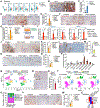Stromal SOX2 Upregulation Promotes Tumorigenesis through the Generation of a SFRP1/2-Expressing Cancer-Associated Fibroblast Population
- PMID: 33207226
- PMCID: PMC7856011
- DOI: 10.1016/j.devcel.2020.10.014
Stromal SOX2 Upregulation Promotes Tumorigenesis through the Generation of a SFRP1/2-Expressing Cancer-Associated Fibroblast Population
Abstract
Cancer-associated fibroblasts (CAFs) promote tumor malignancy, but the precise transcriptional mechanisms regulating the acquisition of the CAF phenotype are not well understood. We show that the upregulation of SOX2 is central to this process, which is repressed by protein kinase Cζ (PKCζ). PKCζ deficiency activates the reprogramming of colonic fibroblasts to generate a predominant SOX2-dependent CAF population expressing the WNT regulator Sfrp2 as its top biomarker. SOX2 directly binds the Sfrp1/2 promoters, and the inactivation of Sox2 or Sfrp1/2 in CAFs impaired the induction of migration and invasion of colon cancer cells, as well as their tumorigenicity in vivo. Importantly, recurrence-free and overall survival of colorectal cancer (CRC) patients negatively correlates with stromal PKCζ levels. Also, SOX2 expression in the stroma is associated with CRC T invasion and worse prognosis of recurrence-free survival. Therefore, the PKCζ-SOX2 axis emerges as a critical step in the control of CAF pro-tumorigenic potential.
Keywords: CMS4; PKCz; SFRP; SOX2; TGFβ; atypical PKCs; cancer-associated fibroblasts; colorectal cancer; metastasis; stroma.
Copyright © 2020 Elsevier Inc. All rights reserved.
Conflict of interest statement
Declaration of Interests The authors declare no competing interests.
Figures







Comment in
-
Stromal WNTer Keeps the Tumor Cold and Drives Metastasis.Dev Cell. 2021 Jan 11;56(1):3-4. doi: 10.1016/j.devcel.2020.12.011. Dev Cell. 2021. PMID: 33434524
References
-
- Becht E, de Reynies A, Giraldo NA, Pilati C, Buttard B, Lacroix L, Selves J, Sautes-Fridman C, Laurent-Puig P, and Fridman WH (2016). Immune and Stromal Classification of Colorectal Cancer Is Associated with Molecular Subtypes and Relevant for Precision Immunotherapy. Clin Cancer Res 22, 4057–4066. - PubMed
-
- Bhowmick NA, Chytil A, Plieth D, Gorska AE, Dumont N, Shappell S, Washington MK, Neilson EG, and Moses HL (2004). TGF-beta signaling in fibroblasts modulates the oncogenic potential of adjacent epithelia. Science 303, 848–851. - PubMed
-
- Calon A, Lonardo E, Berenguer-Llergo A, Espinet E, Hernando-Momblona X, Iglesias M, Sevillano M, Palomo-Ponce S, Tauriello DV, Byrom D, et al. (2015). Stromal gene expression defines poor-prognosis subtypes in colorectal cancer. Nat Genet 47, 320–329. - PubMed
-
- Calvo F, Ege N, Grande-Garcia A, Hooper S, Jenkins RP, Chaudhry SI, Harrington K, Williamson P, Moeendarbary E, Charras G, and Sahai E (2013). Mechanotransduction and YAP-dependent matrix remodelling is required for the generation and maintenance of cancer-associated fibroblasts. Nat Cell Biol 15, 637–646. - PMC - PubMed
Publication types
MeSH terms
Substances
Grants and funding
LinkOut - more resources
Full Text Sources
Other Literature Sources
Medical
Molecular Biology Databases

